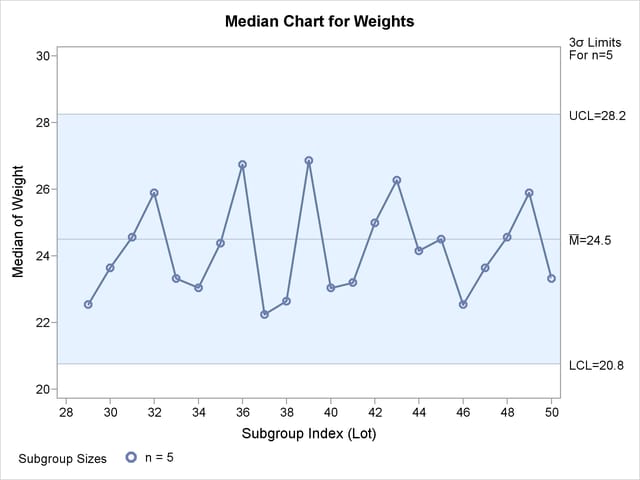MCHART Statement: SHEWHART Procedure
Note: See Median Chart Examples in the SAS/QC Sample Library.
In the previous example, the OUTLIMITS= data set Detlim saved control limits computed from the measurements in Detergent. This example shows how these limits can be applied to new data provided in the following data set:
data Detergent2;
input Lot @;
do i=1 to 5;
input Weight @;
output;
end;
drop i;
datalines;
29 16.66 27.49 18.87 22.53 24.72
30 23.74 23.67 23.64 20.26 22.09
31 24.56 24.82 23.92 26.67 21.38
32 25.89 28.73 29.21 25.38 23.47
33 23.32 21.61 30.75 23.13 23.82
34 23.04 22.65 24.96 19.64 26.84
35 24.01 24.38 24.86 26.50 24.37
36 26.43 27.36 28.74 26.74 26.27
37 21.41 22.24 25.34 20.59 27.51
38 22.62 20.81 22.64 30.15 25.32
39 26.86 28.14 24.06 27.35 22.49
40 23.03 23.83 25.59 19.85 22.33
41 23.19 23.63 23.00 21.46 27.57
42 27.38 23.18 24.99 24.81 28.82
43 26.60 26.58 20.26 26.27 24.96
44 26.22 23.28 24.15 24.06 28.23
45 25.90 22.88 25.55 24.50 19.95
46 16.66 27.49 18.87 22.53 24.72
47 23.74 23.67 23.64 20.26 22.09
48 24.56 24.82 23.92 26.67 21.38
49 25.89 28.73 29.21 25.38 23.47
50 23.32 21.61 30.75 23.13 23.82
;
The following statements create a median chart for the data in Detergent2 using the control limits in Detlim:
ods graphics on; title 'Median Chart for Weights'; proc shewhart data=Detergent2 limits=Detlim; mchart Weight*Lot / odstitle=title markers; run; ods graphics off;
The ODS GRAPHICS ON statement specified before the PROC SHEWHART statement enables ODS Graphics, so the median chart is created using ODS Graphics instead of traditional graphics. The chart is shown in Figure 17.41.
The LIMITS= option in the PROC SHEWHART statement specifies the data set containing the control limits. By default, this information is read from the first observation in the LIMITS= data set for which
-
the value of
_VAR_matches the process nameWeight -
the value of
_SUBGRP_matches the subgroup-variable nameLot
The chart indicates that the process is in control, since all the medians lie within the control limits.
In this example, the LIMITS= data set was created in a previous run of the SHEWHART procedure. You can also create a LIMITS= data set with the DATA step. See LIMITS= Data Set for details concerning the variables that you must provide.

